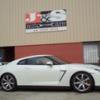R35 Horsepower Figures
Announcements
-
Similar Content
-
Latest Posts
-
My take on gg2 48mm, 54mm, 58mm, and 62mm compressor map for same size compressor vs gg1 : All gg2 only outflow gg1 above 20 psi. As all g gen 2 surge line at lower left of comp map move to the right, all gg2 sacrifice spool vs same size gg1, surge line move to the right worst for 54mm gg2. So for same size compressor if you want best response, use gg1, if you want max hp at >20psi use gg2 but you will be laggier vs same size gg1. Max compressor efficiency drops to max 75% on all gg2 vs max 76%-80% of same size gg1. Iirc lower efficiency means hotter iat less dense air so lower hp at same operating point of comp map. Also curious why gg2 is mapped to lower max rpm vs same size gg1 (only 48mm size both gg1 gg2 mapped to same rpm) : 54mm gg1 165,000 rpm vs gg2 160,000 rpm. 58mm gg1 150,000 rpm vs gg2 140,000rpm. 62mm gg1 145,000 rpm vs gg2 140,000 rpm. If gg2 can safely spin to gg1 rpm then they can flow a bit more than as mapped. Good thing that all gg 2 interchange compressor and turbine housings with same size gg 1. So gg1 owners can buy gg2 chra only if planning to boost >20psi.
-
My stuff is all with Shannon's, granted, I don't really have imports I'm driving on the road, however, I've had multiple cars at the same time with them. Presently we have the Landcruiser on laid up cover, Sarah's Kluger on full cover, and the house insured. About 18 months ago Sarah wrote her Subaru Liberty GTB off, insured with Shannon's, and the payout, and buy back of the wreck was super quick. In 2020 we had the VF Commodore totalled in a major hailstorm. Storm was on the Saturday, I called on the Sunday and lodged it, vehicle was towed on Tuesday night, assessment team called on Wednesday to say it was a total loss and get payout details, money was in the bank on Thursday morning. Have had a few other claims both at fault, and not at fault, over the years, and never had an issue with them. Funnily enough, they're also the cheapest insurer I find for things like Sarah's Kluger. I will say I'm less impressed dealing with them lately around "the experience", as a lot of their staff that you deal with aren't car enthusiasts. Shannon's has a much more main stream feel ever since they decided to become "big corporate", laid a heap of staff off, and then hired a bunch of non enthusiasts. At the same time they've been making a push to be less "call us and we'll personally have someone who cares help" to "hey, this computer can do stuff for you" and are trying to get more square pegs to fit round holes. (That's just the vibe I get from them). Again, have had no issues with claims with them, but get a bit of a "less personal" feel from them.
-
A thing I wasn’t happy with with enthusiast was during the initial phone call they told me they’d insure it for 130k but needed photos. I then sent them photos and they told me $80k as there were other cars either similar modifications available for around that price, I told them to send me the links to said cars so that I can buy them. i then sent the modification list with prices of the parts (no labor) and the price then came to 115k, which is still shy of the 130 that was agreed in the initial phone call
-
I agree that delayed payment probably isn't the most suitable solution. It seems a solid complete transaction would be best. As I wouldn't be using this sale as a line of credit that would typically earn interest, we can probably arrange a much cleaner single transaction deal. I can do $92.52 today. Would you prefer EFT, or Cash on Pickup? 😛
-







Recommended Posts
Create an account or sign in to comment
You need to be a member in order to leave a comment
Create an account
Sign up for a new account in our community. It's easy!
Register a new accountSign in
Already have an account? Sign in here.
Sign In Now